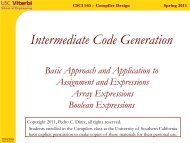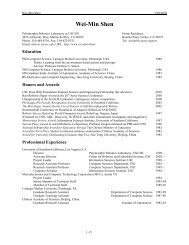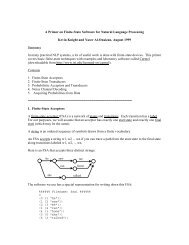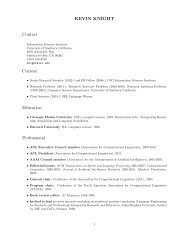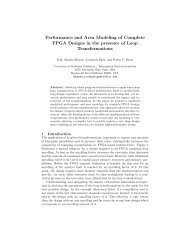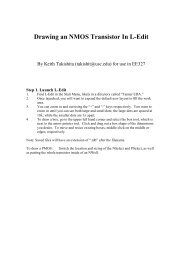Induction of Word and Phrase Alignments for Automatic Document ...
Induction of Word and Phrase Alignments for Automatic Document ...
Induction of Word and Phrase Alignments for Automatic Document ...
Create successful ePaper yourself
Turn your PDF publications into a flip-book with our unique Google optimized e-Paper software.
Computational Linguistics Volume 1, Number 1<br />
Example 1:<br />
... <strong>and</strong> OS/2 must provide additional capabilities that justify the expense <strong>and</strong> ef<strong>for</strong>t <strong>of</strong> migrating to it from DOS .<br />
The transition from DOS to OS/2 has no real precedents . . . . OS/2 must provide additional capabilities that are sufficient to justify the expense <strong>and</strong> ef<strong>for</strong>t required to migrate to it .<br />
Example 2:<br />
The DMP 300 produces good − quality graphics <strong>and</strong> highly readable text .<br />
Graphics quality is good , with the printer producing a remarkably smooth curved line . . . . but still eminently readable text<br />
. . . . The DMP 300 . . . .<br />
Figure 8<br />
Erroneous alignments are in bold. (Top) Example <strong>of</strong> an error made by our model (from file<br />
ZF207-585-936). “From DOS” should be null generated, but the model has erroneously aligned it<br />
to an identical phrase that appeared 11 sentences earlier in the document. (Bottom) Error (from<br />
ZF207-772-628); “The DMP 300” should be aligned to “the printer” but is instead aligned to a<br />
far-away occurrence <strong>of</strong> “The DMP 300.”<br />
method, achieving a precision <strong>of</strong> 0.522 <strong>and</strong> a recall <strong>of</strong> 0.712, yielding an overall F-score <strong>of</strong><br />
0.606 when stop words are not considered. This is still below the human-against-human<br />
f-score <strong>of</strong> 0.775 (especially considering that the true human-against-human scores are<br />
1.0), but significantly better than any <strong>of</strong> the other models.<br />
Among the three settings <strong>of</strong> our jump table, the syntax-based model per<strong>for</strong>ms best,<br />
followed by the relative jump model, with the Gaussian model coming in worst (though<br />
still better than any other approach). Inspecting Figure 2, the fact that the Gaussian<br />
model does not per<strong>for</strong>m well is not surprising: the data shown there is very non-<br />
Gaussian. A double-exponential model might be a better fit, but it is unlikely that such a<br />
model will outper<strong>for</strong>m the syntax based model, so we did not per<strong>for</strong>m this experiment.<br />
5.3 Error analysis<br />
The first mistake frequently made by our model is to not align summary words to null.<br />
In effect, this means that our model <strong>of</strong> null-generated summary words is lacking. An<br />
example <strong>of</strong> this error is shown in Example 1 in Figure 8. In this example, the model has<br />
erroneously aligned “from DOS” in the abstract to “from DOS” in the document (the error<br />
is shown in bold). This alignment is wrong because the context <strong>of</strong> “from DOS” in the<br />
document is completely different from the context it appears in in the summary. However,<br />
the identity rewrite model has overwhelmed the locality model <strong>and</strong> <strong>for</strong>ced this<br />
incorrect alignment. To measure the frequency <strong>of</strong> such errors, we have post-processed<br />
our system’s alignments so that whenever a human alignment contains a null-generated<br />
summary word, our model also predicts that this word is null-generated. Doing so will<br />
not change our system’s recall, but it can improve the precision. Indeed, in the case<br />
<strong>of</strong> the relative jump model, the precision jumps from 0.456 to 0.523 (f-score increases<br />
from 0.548 to 0.594) in the case <strong>of</strong> all words <strong>and</strong> from 0.512 to 0.559 (f-score increases<br />
from 0.593 to 0.624). This corresponds to a relative improvement <strong>of</strong> roughly 8% f-score.<br />
Increases in score <strong>for</strong> the syntax-based model are roughly the same.<br />
The second mistake our model frequently makes is to trust the identity rewrite<br />
model too strongly. This problem has to do either with synonyms that do not appear frequently<br />
enough <strong>for</strong> the system to learn reliable rewrite probabilities, or with coreference<br />
issues, in which the system chooses to align, <strong>for</strong> instance, “Micros<strong>of</strong>t” to “Micros<strong>of</strong>t,”<br />
rather than “Micros<strong>of</strong>t” to “the company,” as might be correct in context. As suggested<br />
by this example, this problem is typically manifested in the context <strong>of</strong> coreferential noun<br />
20





